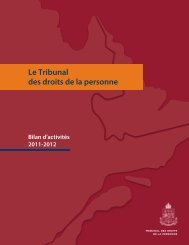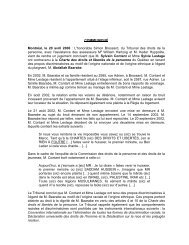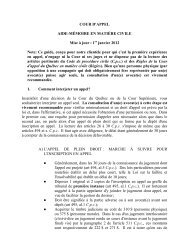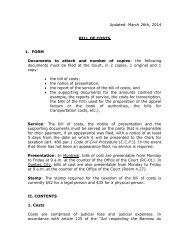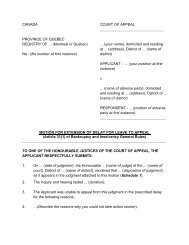Le Tribunal des droits de la personne
Bilan d'activités 2006-2007 - Tribunaux judiciaires du Québec
Bilan d'activités 2006-2007 - Tribunaux judiciaires du Québec
- No tags were found...
You also want an ePaper? Increase the reach of your titles
YUMPU automatically turns print PDFs into web optimized ePapers that Google loves.
LES ACTIVITÉS DU TRIBUNALLa formation et le perfectionnement2. La discrimination systémique : Puisque <strong>la</strong> discrimination systémique remeten cause les institutions et les politiques, le <strong>Tribunal</strong> pourrait avoir un rôledans <strong>la</strong> surveil<strong>la</strong>nce <strong><strong>de</strong>s</strong> programmes proactifs ; il serait possible égalementd’imaginer un système dans lequel il y a un accès direct au <strong>Tribunal</strong> pour lesp<strong>la</strong>intes individuelles, tout en conservant <strong>la</strong> compétence <strong>de</strong> <strong>la</strong> Commissionquant aux p<strong>la</strong>intes systémiques. <strong>Le</strong> défi consiste donc à i<strong>de</strong>ntifier les p<strong>la</strong>intesindividuelles ayant un fon<strong>de</strong>ment systémique.3. <strong>Le</strong> contexte structurel et global <strong><strong>de</strong>s</strong> inégalités : Il s’agit <strong>de</strong> s’intéresser auxproblèmes sociaux qui ne peuvent être résolus par une réparation ou unedécision du <strong>Tribunal</strong>, par exemple <strong>la</strong> pauvreté ou le manque d’éducation.4. L’émergence <strong><strong>de</strong>s</strong> mouvements sociaux : Madame Sheppard soulignel’importance <strong><strong>de</strong>s</strong> mouvements sociaux en référant à l’arrêt Action Travail <strong><strong>de</strong>s</strong>femmes 88, rendu en 1987 par <strong>la</strong> Cour suprême du Canada.Au p<strong>la</strong>n <strong><strong>de</strong>s</strong> principes <strong>de</strong> base, madame Sheppard insiste sur l’importance <strong>de</strong> mainteniren p<strong>la</strong>ce une infrastructure publique pour <strong>la</strong> protection <strong><strong>de</strong>s</strong> <strong>droits</strong> <strong>de</strong> <strong>la</strong> <strong>personne</strong>. Ellementionne également que l’accès à <strong>la</strong> justice implique aussi d’éviter d’aller <strong>de</strong>vant lestribunaux.Finalement, quant à <strong>la</strong> question <strong>de</strong> l’accès au <strong>Tribunal</strong> <strong><strong>de</strong>s</strong> <strong>droits</strong> <strong>de</strong> <strong>la</strong> <strong>personne</strong>, elle relèvequelques aspects importants dont notamment le coût abordable,le dé<strong>la</strong>i raisonnable, l’expertise <strong><strong>de</strong>s</strong> adjudicateurs et lesremè<strong><strong>de</strong>s</strong> créatifs.De gauche à droite sur <strong>la</strong> photo : Madame Colleen Sheppard,professeure à <strong>la</strong> Faculté <strong>de</strong> droit <strong>de</strong> l’Université McGill,Me Michael Gottheil, prési<strong>de</strong>nt du <strong>Tribunal</strong> <strong><strong>de</strong>s</strong> <strong>droits</strong> <strong>de</strong> <strong>la</strong><strong>personne</strong> <strong>de</strong> l’Ontario et monsieur Doug Ewart, coordonnateurgénéral, conception et mise en oeuvre <strong>de</strong> <strong>la</strong> réforme du<strong>Tribunal</strong> <strong><strong>de</strong>s</strong> <strong>droits</strong> <strong>de</strong> <strong>la</strong> <strong>personne</strong> <strong>de</strong> l’Ontario.<strong>Le</strong>s principaux aspects <strong>de</strong> <strong>la</strong> réforme en cours en Ontario,conférence <strong>de</strong> M e Michael Gottheil, prési<strong>de</strong>nt, <strong>Tribunal</strong> <strong><strong>de</strong>s</strong><strong>droits</strong> <strong>de</strong> <strong>la</strong> <strong>personne</strong> <strong>de</strong> l’Ontario, et monsieur Doug Ewart,coordonnateur général, conception et mise en œuvre <strong>de</strong> <strong>la</strong>réforme, <strong>Tribunal</strong> <strong><strong>de</strong>s</strong> <strong>droits</strong> <strong>de</strong> <strong>la</strong> <strong>personne</strong> <strong>de</strong> l’Ontario.D’abord, M e Gottheil présente le système actuel <strong><strong>de</strong>s</strong> <strong>droits</strong> <strong>de</strong><strong>la</strong> <strong>personne</strong> en Ontario. Il mentionne que <strong>la</strong> principale dis-88 Compagnie <strong><strong>de</strong>s</strong> chemins <strong>de</strong> fer nationaux du Canada c. Canada (Commission <strong><strong>de</strong>s</strong> <strong>droits</strong> <strong>de</strong> <strong>la</strong> <strong>personne</strong>), [1987] 1 R.C.S.1114.90



